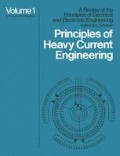Abstract
Electricity is a difficult subject to understand and the main reason is that we cannot see the things we are thinking about. A consequence is that numerous analogies and models are used. For example, when dealing with current electricity, the idea of a flow immediately suggests the idea of water flowing in a pipe. All the water keeps to the pipe except where there is a leak and similarly all the electric current keeps to the wire. A leak is a path offering low resistance to the flow of water and, with electricity, if a path of low resistance is offered to the current, the current will take it — such a path is known as a short circuit and the results can be as spectacular as a burst water main. In the case of electricity, we will be tempted to ask what is it that is flowing? The answer will probably come back ‘electrons’ and then there will be difficult explanations about positive and negative charges. We shall not pursue this line at this stage other than to remark that no one has seen an electron although we can see results which could have been produced by electrons. There is another idea which is easy enough to grasp, when we are thinking about water in pipes, and that is the idea of pressure. Similarly when dealing with electricity we think of something akin to pressure which forces the electrons, or whatever it is that constitutes current, from one part of the wire to another. Many water supply systems use gravity to push the water along and we think of a reservoir high on a hill, where the water has the potential to come down to be used. If allowed to escape from a pipe at the bottom of the hill it would be moving with speed and its energy could be used to push round a water wheel and do work.
Access this chapter
Tax calculation will be finalised at checkout
Purchases are for personal use only
Preview
Unable to display preview. Download preview PDF.
Rights and permissions
Copyright information
© 1974 Chapman and Hall Ltd
About this chapter
Cite this chapter
Lund, P.G. (1974). Electric and Magnetic Fields. In: Principles of Heavy Current Engineering. A Review of the Principles of Electrical & Electronic Engineering. Springer, Dordrecht. https://doi.org/10.1007/978-94-011-6899-1_1
Download citation
DOI: https://doi.org/10.1007/978-94-011-6899-1_1
Publisher Name: Springer, Dordrecht
Print ISBN: 978-0-412-11660-5
Online ISBN: 978-94-011-6899-1
eBook Packages: Springer Book Archive

